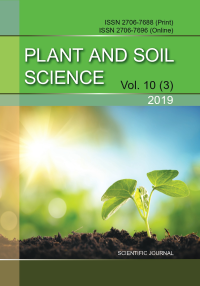Influence of nitrogen nutrition and weed protection of crops on productivity of soybeans in the Right-bank Forest-steppe of Ukraine
DOI:
https://doi.org/10.31548/agr2019.03.055Keywords:
soybeans, soil and post-emergence herbicides, technical effectivity, tank mixtures, inoculation, nitrogen fertilizers, effectivity of applicationAbstract
In this article results of two years old researches of joint influence of chemical protection of crops from weeds, nitrogen mineral fertilizers and inoculation of sowing material on productivity and quality of soybean harvests in the Right-bank Forest-Steppe of Ukraine were analyzed.
Field experiments in the course of from 2017 to 2018 were conducted in a stationary crop rotation of the laboratory of selection and seed production of the separated subdivision of National University of Life and Environmental Sciences of Ukraine “Agronomic Research Station” in a village Pshenychne of Vasylkivsky district of Kyiv region.
It was found out that tank mixtures of herbicides provided high-level technical efficiency under conditions of a mixed type of weediness in both soil – Zenkor (0,4 l/ha) + Kommand (0,2 l/ha) and post-emergence ones – Basagran (2,5 l/ha) + Harmony (0,008 kg/ha). In the specified doses, two-component mixtures of herbicides lowered a total number of monocot and dicotyledonous weeds by 41-78 percent on the 30th day after introduction and by 61-67 percent before harvesting, and lowered crude weight of all the weeds almost by 80 percent.
It was noticed that effective control of weediness of crops with a mixture of drugs Zenkor and Kommand, preliminary inoculation and introduction of nitrogen mineral fertilizers in a dose N90, promoted increment of plant productivity and formation of higher yield. Its veracious increase in relation to a control without inoculation, fertilizers and chemical weeding achieved almost 3 tons per hectare or closely to 300 percent on these variants. At the same time, negative influence of endogenous mineral nitrogen and an herbicide background on processes of biologic nitrogen fixation in soil wasn’t revealed.
Results of researches show positive influence of rational use of agrotechnical measures listed above on improvement of soybean harvest quality, in particular on increment of protein contents in grains by 6,4 percent.References
Hutianskyi R.A. (2013). Efektyvnist poiednannia triokh pisliaskhodovykh herbitsydiv u posivakh soi [Effectivity of combination of three post-emergence herbicides in soybean crops]. Scientific and technical bulletin of Institute of oil plants of NAAS, 18, 72-78.
Shepilova T.P. (2016). Efektyvnist dii herbitsydiv v posivakh soi [Effectivity of herbicide action in soybean crops]. Messenger of Uhman National University of gardening, 1, 7-9.
Hutianskyi R.A. (2008). Efektyvnist antyburianovykh pryiomiv. Dohliad za posivamy soi pry kombinovanomu zastosuvanni ahrotekhnichnykh ta khimichnykh zakhodiv [Effectivity of anti-weed measures. Care of soybean crops at combined applying of agrotechnical and chemical measures]. Quarantine and protection of plants, 7, 22-24.
Huralchuk Zh.Z., Sorokina S.I., Rodzevych O.P., Morderer Ye.Yu. (2012). Azotfiksuvalna aktyvnist soi za sumisnoho zastosuvannia herbitsydiv i mikrodobryv [Soybean nitrogen-fixing activity at combined application of herbicides with microfertilizers]. Scientific notes of Tauride V. Vernadsky National University. Series: biology, chemistry. 25(64), 4, 34-41.
Rekomendaсii po primeneniyu Rizotorfina v tehnologii vozdelyvaniya bobovyh kul’tur [Recommendations about applying of Risotorphine in the technology of production of legume cultivars] (1987). Kyiv, Ukraine: Yield, 21 p.
Datsenko V.K., Malichenko S.M., Berehovenko S.K., Kots S.Ya. (2001). Novi ahrokhimikaty yak zasib pidvyshchennia azotfiksuvalnoi zdatnosti soi [New agrochemicals as a way of increment of soybean nitrogen-fixation facility]. Collection “Plant ontogenesis, biological fixation of molecular nitrogen and nitrogenous metabolism”, Ternopil, 69-72.
Pyshchur I.M., Kanivets V.I., Larchenko I.V. (2014).Vplyv suchasnykh herbitsydiv na formuvannia soievo-ryzobialnoho symbiozu za vykorystannia mikrobnoho preparatu Ryzohuminu [Influence of modern herbicides on soybean-rhizobial symbiosis formation at use of a bacterium drug Rhyzogumin]. Agricultural microbiology, 8, 100-108.
Kulyk M.F., Zhmud O.V., Babych A.O., Zasukha T.V., Obertiukh Yu.V., Kulyk Ya.M., Zelinska N.B. (2010). Do pytannia biolohichno aktyvnykh rechovyn soi [To an issue of soybean biologically active substances]. Messenger of an agrarian science, 10, 28-33.
Zherebko V.M., Zherebko Yu.V., Chernega T.A. (2000). Effektivnost’ regulirovaniya urovnya zasoryonnosti posevov soi v Lesostepi Ukrainy [Effectivity of regulation of a soybean crop weediness standard in the Forest-Steppe of Ukraine]. State and development of herbology on the threshold of the 21th century. Materials of the second All-Russian scientific and manufacturing consultation. Golitsyno, Russian, 114-118.
Zherebko V.M. (2015). The impact of weeds and care of crops qualitative indicators of soybean crop. Scientific reports of National University of Life and Environmental Sciences of Ukraine, 7. Available at: http://nbuv.gov.ua/UJRN/Nd_2015_7_11.
Downloads
Additional Files
- ВПЛИВ АЗОТНОГО ЖИВЛЕННЯ І ЗАХИСТУ ПОСІВІВ ВІД БУР’ЯНІВ НА ПРОДУКТИВНІСТЬ СОЇ В ПРАВОБЕРЕЖНОМУ ЛІСОСТЕПУ УКРАЇНИ (Українська)
- INFLUENCE OF NITROGEN NUTRITION AND PROTECTION FROM WEEDS ON PRODUCTIVITY OF SOYBEANS IN THE RIGHT-BANK FOREST-STEPPE OF UKRAINE (Українська)
- ВІДОМОСТІ ПРО АВТОРІВ (Українська)
Published
Issue
Section
License
Relationship between right holders and users shall be governed by the terms of the license Creative Commons Attribution – non-commercial – Distribution On Same Conditions 4.0 international (CC BY-NC-SA 4.0):https://creativecommons.org/licenses/by-nc-sa/4.0/deed.uk
Authors who publish with this journal agree to the following terms:
- Authors retain copyright and grant the journal right of first publication with the work simultaneously licensed under a Creative Commons Attribution License that allows others to share the work with an acknowledgement of the work's authorship and initial publication in this journal.
- Authors are able to enter into separate, additional contractual arrangements for the non-exclusive distribution of the journal's published version of the work (e.g., post it to an institutional repository or publish it in a book), with an acknowledgement of its initial publication in this journal.
- Authors are permitted and encouraged to post their work online (e.g., in institutional repositories or on their website) prior to and during the submission process, as it can lead to productive exchanges, as well as earlier and greater citation of published work (See The Effect of Open Access).

